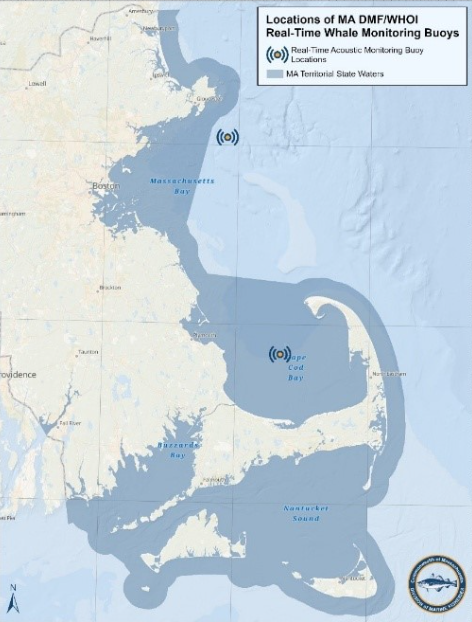- Department of Fish and Game
- Division of Marine Fisheries
Media Contact
Julia E. Hopkins, Communications Director
BOSTON — The Massachusetts Department of Fish & Game’s (DFG) Division of Marine Fisheries (DMF) has partnered with Woods Hole Oceanographic Institution (WHOI) to launch an innovative passive acoustic monitoring network. This network will collect near-real-time information about the presence of North Atlantic right whales off the Massachusetts coast.
Earlier this year, researchers deployed two buoys off the coast of Cape Ann and Cape Cod Bay. Developed by WHOI, the acoustic monitoring system will listen for, detect, classify, and report vocalizations of large whales in near real-time, with data transmitted to shore every two hours. Acoustic analysts then review the data to confirm detections and verify species. This critical data will help DMF better understand right whale presence, inform dynamic management of seasonal fishing closures and speed restrictions, and support future conservation measures. Additionally, these buoys are part of a larger real-time monitoring network along the East Coast. Data from the buoys is publicly available on Robots4Whales.
“Massachusetts has a special responsibility to conserve North Atlantic Right Whales. Each season, we host over two-thirds of the remaining 370 individuals right here in Cape Cod Bay,” said DFG Commissioner Tom O’Shea. “While incredible progress has been made, human impacts and climate change continue to threaten the survival of this species. Strong partnerships give this species the best chance of recovery.”
“Massachusetts has long been a leader in right whale protection efforts and has the most stringent state regulations to protect right whales in the country, said Division of Marine Fisheries Director Dan McKiernan. “With this new data, DMF can build on our existing monitoring efforts and leverage the best available science to achieve coexistence.”
“Within a few hours of the buoys being in the water, they were already picking up detections, including vocalizations of right whales in Cape Cod Bay,” said DMF Protected Species Program Manager Erin Burke. “DMF is grateful to partner with researchers at WHOI to launch this innovative acoustic monitoring network to better understand North Atlantic right whales and educate the public.”
“We are excited to partner with DMF to add Cape Ann and Cape Cod Bay sites to the network of 11 buoys monitoring for right whales along the East Coast”, said Dr. Mark Baumgartner of WHOI. “The data from these systems are improving awareness of right whale presence in our marine backyard and helping to support important dynamic management measures to reduce risks to this highly endangered species.”
Massachusetts’ real-time monitoring effort is part of a broader North Atlantic right whale conservation and monitoring effort by DMF’s Protected Species Program. This program also includes archival passive acoustic monitoring as well as expanded aerial surveillance efforts in partnership with the Center for Coastal Studies. Together, these monitoring approaches provide data that will contribute to a better understanding of endangered right whales and assist in efforts to reduce harm from human impacts.
Learn more about DMF’s Protected Species Program, explore right whale monitoring data at WHALE map, and visit Robots4Whales to discover the latest whales heard off our coast.
###




